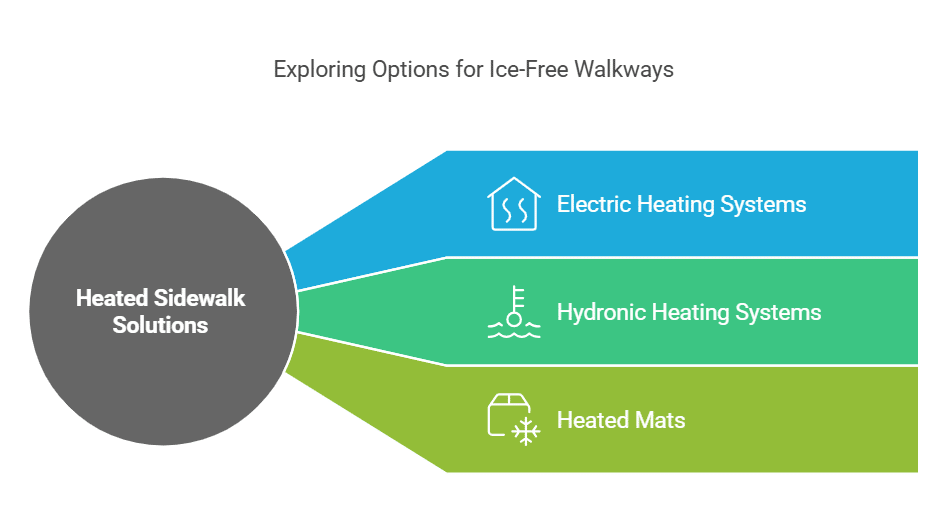Winter is beautiful, but it comes with its fair share of challenges—especially when keeping sidewalks clear of ice. If you’re out working all day, the last thing you want to come home to is a slippery, dangerous walkway that could cause an accident. Not only can icy sidewalks be hazardous to you and your family, but they also pose a risk to neighbors and passersby. Worse, if someone slips and gets hurt, you could be held liable, potentially needing the assistance of a slip and fall attorney Tampa. So, how can you make sure your sidewalk stays safe even when you’re not home? Let’s explore some effective solutions to keep your walkways ice-free throughout winter.
1. Apply Ice Melt Before You Leave for Work
One of the simplest ways to prevent ice buildup is to be proactive. Applying ice melt products, such as rock salt, calcium chloride, or magnesium chloride, before you head out for work can help keep the ice from forming in the first place. These products lower the freezing point of water, which prevents the formation of dangerous ice patches.
Pro Tip: Not all ice melts are created equal. Calcium chloride works quickly and is effective in extremely cold temperatures, while magnesium chloride is more environmentally friendly and less harsh on concrete. Based on your needs, pick the right one.
2. Use Sand or Kitty Litter for Traction
If you don’t have time to apply ice melt before heading out, or if temperatures are too low for ice melt to be effective, sprinkling sand or non-clumping kitty litter can provide grip on slippery areas. While this won’t melt the ice, it will reduce the risk of slipping.
Bonus: If you have an old-fashioned push spreader for fertilizer or seed, you can fill it with sand or litter and quickly distribute it over your sidewalk before leaving home.
3. Install a Heated Sidewalk System
A heated sidewalk system may be worth considering if you live in an area with consistently icy conditions and are looking for a long-term solution. These systems use electric or hydronic heating to keep walkways free of ice and snow. While the upfront cost can be significant, the convenience and safety benefits make it a worthwhile investment for some homeowners.
Alternative: If installing a heated sidewalk is impossible, consider heated mats. These portable, plug-in mats can be placed on walkways to melt ice throughout the day.
4. Hire a Snow Removal Service or a Local Helper
Outsourcing is always an option if you’re too busy to handle ice removal. Many snow removal services offer sidewalk clearing in addition to driveway plowing. Alternatively, hiring a neighborhood teenager or a local handyman to spread ice melt or shovel for you can be an affordable and effective way to keep your sidewalk safe.
Tip: If you hire a professional service, ensure they are reliable and available even when you’re at work. Some services even offer seasonal contracts that automatically include regular maintenance during snowy months.
5. Use a Smart Timer or Wi-Fi-Controlled Ice Melt Spreader
Technology can help keep walkways clear. Smart Wi-Fi-controlled ice melt spreaders can be programmed to activate at certain times or even controlled remotely through your phone. If an unexpected freeze occurs while you’re at work, you can deploy a de-icer without being physically present.
6. Keep Your Gutters Clear to Prevent Ice Patches
One often-overlooked cause of sidewalk ice buildup is water runoff from clogged or poorly placed gutters. If melting snow from your roof drips onto your sidewalk and refreezes, you could have a dangerous ice patch waiting for someone to slip on. Make sure your gutters are clear and properly directed away from walkways.
7. Encourage Neighbors to Help Each Other
If you have good relationships with your neighbors, consider working together to keep everyone’s sidewalks safe. A neighborhood system where people look out for each other can be a great way to ensure no one’s walkways go neglected during a workday.
Bonus: Some cities have volunteer groups that help clear ice for elderly or disabled residents. Check if such a program exists in your area.
8. Know Your Local Snow Removal Laws
Many municipalities have laws requiring homeowners to keep sidewalks clear of ice and snow within a certain timeframe. If you’re unsure what the rules are in your area, check with your local government. Staying informed about snow removal laws will help you avoid fines and protect your property.
9. What to Do If Someone Slips on Your Sidewalk
Even with the best precautions, accidents can still happen. If someone falls on your sidewalk, be sure to:
- Check on them immediately to ensure they’re okay and offer assistance.
- Document the scene by taking photos of the conditions and noting your preventive measures (such as spreading ice melt).
- Exchange contact information in case medical issues arise later.
- Consult a lawyer if the person intends to file a claim. Liability laws vary; an attorney can help guide you through the process and protect your interests.
Conclusion
Even when you’re busy working all day, keeping your sidewalk free of ice is all about preparation and using the right tools. From applying ice melt in the morning to investing in heated sidewalk solutions, there are plenty of options to keep your walkways safe. And remember, if someone does take a fall, it’s always wise to consult a slip and fall attorney Tampa to understand your legal responsibilities. By taking these steps, you can ensure a safer winter for yourself, your neighbors, and anyone passing by your home.









































